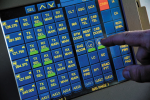midwestpa24
En-Route
- Joined
- Mar 4, 2016
- Messages
- 4,994
- Display Name
Display name:
midwestpa24
Since I have a scanner in my office listening to CTAF and Center, I had a question for our ATC brethren.
How does the coordination communication work between ATC facilities? Is it literally picking up a phone and calling the other facility? Are you able to patch through to the other controller directly? Is there a text message type of system you can use? I often hear Center tell aircraft to standby while they coordinate a request.
How does the coordination communication work between ATC facilities? Is it literally picking up a phone and calling the other facility? Are you able to patch through to the other controller directly? Is there a text message type of system you can use? I often hear Center tell aircraft to standby while they coordinate a request.

